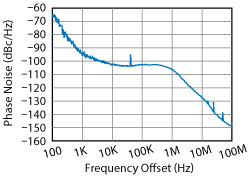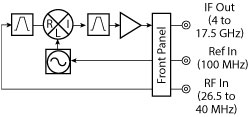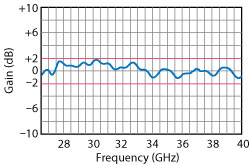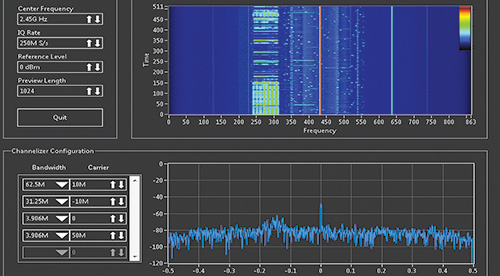
Figure 1 Phase noise of the integrated 44 GHz LO.
The use of millimeter wave frequency bands is making it possible to allocate more bandwidth to deliver faster, larger amounts of data, as well as higher quality multimedia content. Millimeter waves also have the advantage of smaller size components, particularly antennas, as well as ease of frequency reuse. The wireless and microwave world is becoming more and more millimeter wave centric.
Recent industry trends have increased the demand for signal analysis capabilities with wider instantaneous analysis bandwidth, higher frequency and lower cost. This market demand is driven by new application areas such as 5G cellular, next generation Wi-Fi, millimeter wave backhaul, Ka-Band satellite communications and the Internet of Things (IoT). In 2012, National Instruments introduced the NI PXIe-5668R, a best-in-class vector signal analyzer (VSA) with 765 MHz of instantaneous analysis bandwidth up to 26.5 GHz. To serve the demands of the market, the microwave components group of National Instruments (formerly Phase Matrix Inc.) is now offering the PXI-1421, a two-slot PXI, 26.5 to 40 GHz block down-converter module, which extends the operating frequency range of the NI PXI-5668R up to 40 GHz.
The PXI-1421 has an integrated 44 GHz low phase noise local oscillator (LO) (see Figure 1) which block down-converts an RF input between 26.5 and 40 GHz to an IF of 4 to 17.5 GHz, as shown in the block diagram in Figure 2. A fundamental phased-locked oscillator (PLO) based on an 11 GHz VCO is used, with a low noise, ×4 active frequency multiplier followed by an amplifier and filter to achieve the required power output at the final frequency. The 100 MHz reference needed for the PLO is supplied by the NI PXIe-5668R. A high linearity mixer and a medium power IF amplifier are used to meet the stringent spurious requirements. The RF input noise figure of the block down-converter is less than 12 dB, and the input IP3 is better than +22 dBm. The conversion gain from RF input to IF output is typically 1 ± 2 dB (see Figure 3). The IF signal feeds into the NI PXIe-5668R. The residual spur performance of the PXI-1421 is better than -80 dBm.

Figure 2 Block diagram of the PXI-1421 26.5 to 40 GHz block down-converter.

Figure 3 Typical RF to IF conversion gain.
When coupled with the NI PXI-2799 DC to 40 GHz dual SPDT switch, the NI PXIe-5668R, and the PXI-1421, signal analysis can be accomplished from 20 Hz to 40 GHz, all in the PXI form factor. The PXI-1421’s fixed high-side LO (which is outside the band) and the broadband mixer technology allow the preservation of the noise floor of the NI PXI-5668R at 40 GHz (-150 dBm/Hz). The low noise floor of the system allows for phase noise measurements to be made directly up to 40 GHz. In addition, the block down-converter architecture allows for 765 MHz instantaneous analysis bandwidth at 40 GHz, which is useful for measuring adjacent channel power levels of wide bandwidth signals.

Figure 4 PFT-based channelizer using the PXI-7976R FlexRIO FPGA module.
The latest addition to the family of NI’s software-designed instruments, the NI PXIe-5668R includes a LabVIEW programmable Xilinx Kintex-7 FPGA that allows the user to customize the instrument’s behavior by adding triggering or signal processing routines. With the addition of an NI PXI-7976R FlexRIO FPGA module, the user can configure the instrument to do high performance signal processing, such as real-time spectral analysis and narrow band channelizers. Figure 4 shows implementation of a pipelined frequency transform (PFT) based channelizer.
The PXI-1421 extends the NI PXIe-5668R VSA performance up to 40 GHz, which is ideal for a wide range of applications. The combination of excellent analog performance, extremely wide bandwidth and ultimate flexibility empower the user to address challenging measurement applications ranging from ACLR to radar verification to spectrum monitoring.
National Instruments
Austin, Texas
www.ni-microwavecomponents.com
